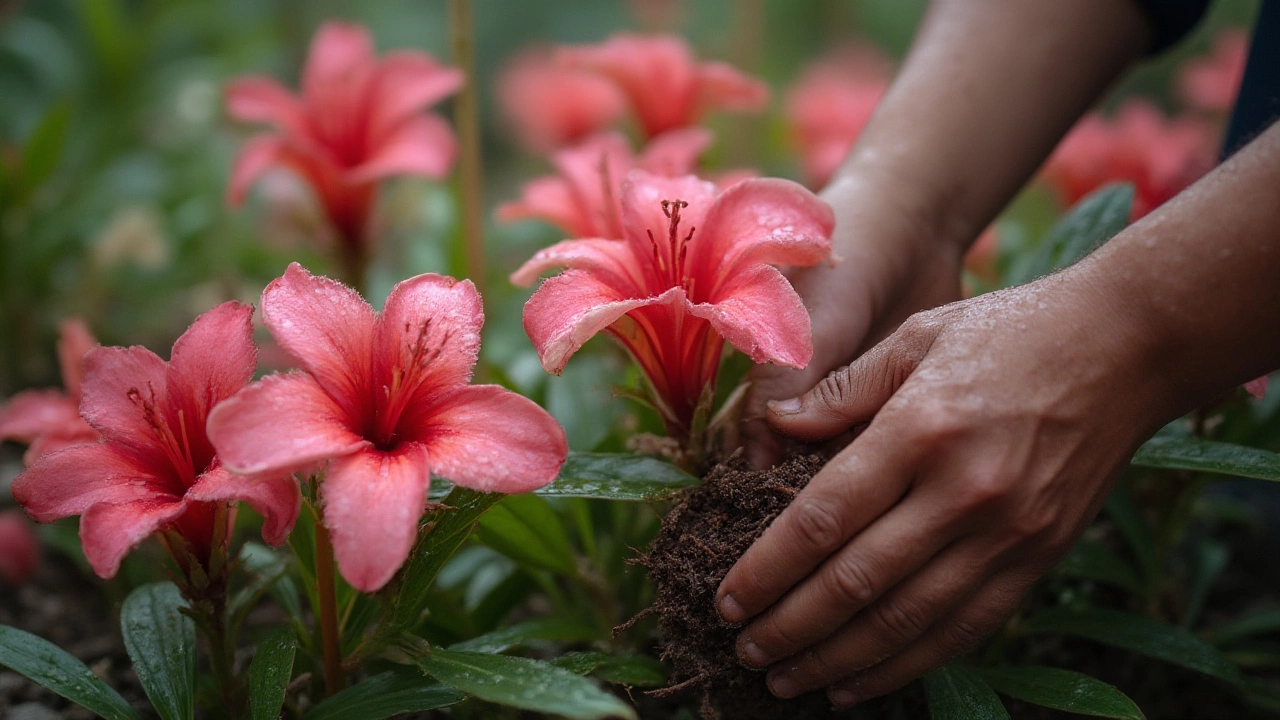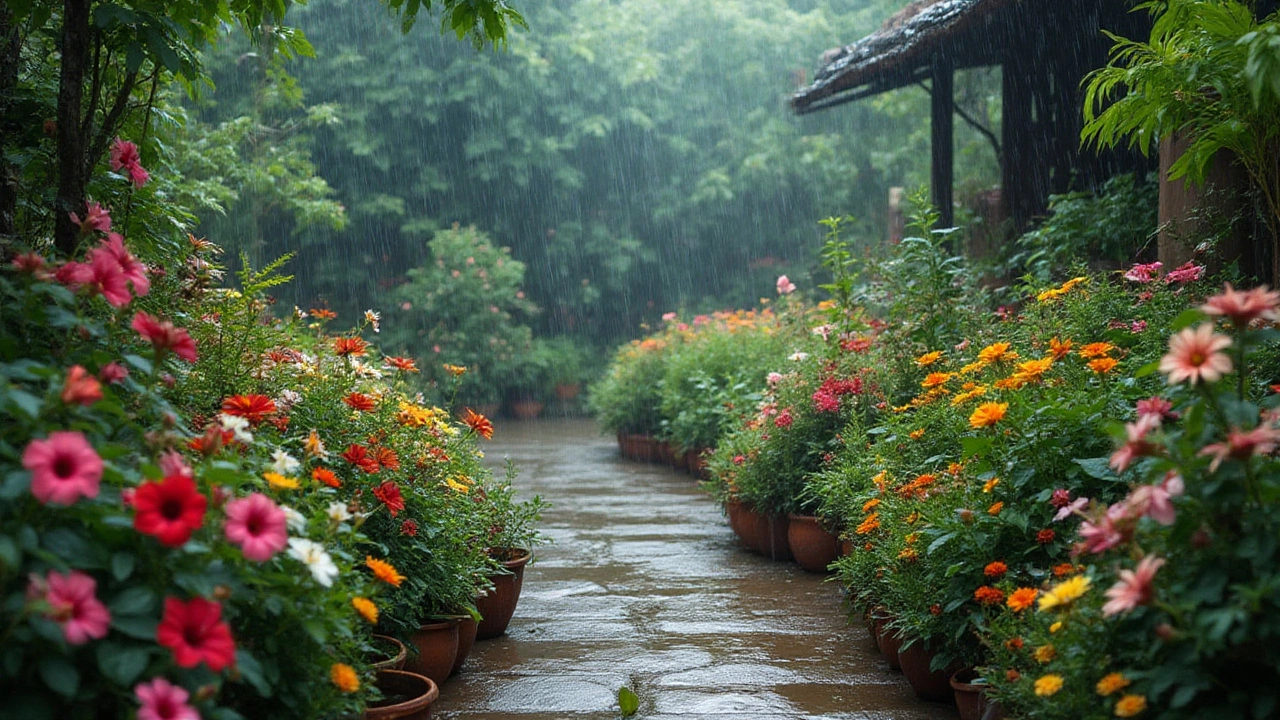It’s July, monsoon clouds have claimed the sky, and the streets of Mumbai are nearly rivers. Every patch of soil wakes up, and something spectacular happens—gardens and wild spaces are suddenly bursting with color as flowers that love the rain start unfolding their petals. While most people grumble about muddy shoes and traffic delays, gardeners in India secretly look forward to the rainy season because it turns their gardens into wild bursts of pinks, yellows, violets, and reds almost overnight. But which flowers actually thrive when the skies turn grey? There’s more to this than just ‘any brightly-colored bloom’ you might spot outside. Let me walk you through the actual, rain-loving champions of the Indian monsoon—and how to make them the star of your garden this season.
The Monsoon’s Magic: Why Some Flowers Love the Rainy Season
Most people think rain spells disaster for flowers, picturing drooping petals and rotting stems. Not true for monsoon-loving varieties. In India, the rainy season typically stretches from June to September, depending on the region. During this stretch, humidity soars, daylight is still plentiful, and the soil remains moist but not waterlogged—if you’re careful. This unique cocktail wakes certain flower species from their dry-season slumber. Many native flowers have evolved to soak up the extra water, using monsoon moisture to bloom harder, brighter, and longer. For some, like the lotus and water lilies, it’s practically a breeding ground. The monsoon’s arrival isn’t just a survival trick: for centuries, this natural cycle has shaped which flowers thrive in India’s fields, gardens, and temple courtyards.
If you want your garden to stand out during monsoon, you must choose flowers that are adapted to heavy rain and humid warmth—not those delicate types that keel over at the first sign of soggy soil. Look for varieties with thick, waxy leaves (they repel water), flowers that shed rain easily, or even blooms that open wider because the conditions are finally right. Understanding local conditions is vital too: what thrives in humid Kerala might struggle in the windy, hillier parts of Uttarakhand. Climate, altitude, soil and even local pollinators play their part, but there are some classics that you’ll find succeed almost anywhere the monsoon reaches.
One reason these flowers do especially well is how India’s rhythmic rain replenishes nutrients that get leached in the dry months, and encourages a flush of microbial life in the soil. All this extra activity helps root systems spread and take up nutrients, allowing monsoon flowers to look their absolute best. If there’s one thing experienced gardeners know, it’s that certain Indian blooms are almost dependent on the annual deluge to show off at full strength.
The Top Rainy Season Flowers in India and Why They Shine
If you stand in a Mumbai park or just peek into your neighbour’s yard in July or August, certain flowers seem to appear everywhere—but that’s not a coincidence. It’s because they’ve been bridegroomed by rain for generations. Want to make a garden that’s monsoon-proof and dazzling? These are the stars of the season:
- Hibiscus: This one’s hard to miss. Huge, bold petals, rich colors, and massive resilience. Hibiscus can handle torrential downpours and still bloom, partly thanks to their sturdy stems. Plus, the plant flowers nearly daily during monsoon, providing a burst of color for months. In some places, it’s even used in religious rituals during the rainy season.
- Lotus (Nelumbo nucifera): The Indian national flower is almost made for the monsoon. It loves shallow water, rising above the floodwaters with its perfect pink petals. You’ll see lotuses gracing temple ponds and even roadside water bodies—and the rain only seems to make them stronger.
- Balsam (Impatiens balsamina): If you want a low-effort flower with massive color payoff, go for balsam. Balsam self-seeds like a boss, sprouting up all over with just a light scatter of rainwater. It comes in bright pink, white, and violet tones that almost glow against stormy skies.
- Marigold: These are the workhorses of the Indian garden. Marigolds aren’t only favored for their yellow-orange pop and pest-repelling properties, but they can tolerate heavy rain as long as you give them a bit of drainage. They’re a staple during the monsoon festival season, used everywhere from flower garlands to home décor.
- Rain Lily (Zephyranthes): You won’t find a more literal monsoon flower. Rain lilies stay buried and nondescript until the first heavy showers, then burst out with star-shaped, white or pink blooms, sometimes in less than 24 hours after rainfall. They’ve got to be one of the most dramatic signs that monsoon is here.
- Tuberose (Rajnigandha): Their heavy, sweet fragrance drifts through monsoon nights. Tuberose doesn’t just survive the rains—it seems to bloom even more madly. The long spikes of waxy white flowers don’t mind being soaked, and Indian gardeners swear by them for scenting the house during muggy months.
- Gulmohar (Delonix regia): The iconic flame tree, with its scarlet-orange flowers blanketing the branches just as the downpours start. Gulmohar lights up parks and avenues throughout South India all monsoon long, although technically, the peak flowering is as the rains get started.
- Jasmine (Jasminum sambac): Beloved in temple offerings and hair garlands, jasmine might not look like much at first glance, but in the monsoon, those tiny buds turn into clusters of scented white blooms. The fragrance is stronger when the air is wet, making monsoon jasmine a favorite for evening relaxation.
What’s the secret to their success? Most of these flowers are native or have been grown in India for so many centuries that they’re practically native. Their tolerance of heavy rains, humidity, and the odd spell of blazing sunshine makes them perfect for anyone who doesn’t want to micromanage every drop of water in their garden.
Here’s a table with quick facts about top rainy season flowers—handy for planning:
| Flower | Flowering Time | Color | Scent | Extra Fact |
|---|---|---|---|---|
| Hibiscus | June-Sept | Red, pink, yellow, white | Mild | Edible petals; good for hair |
| Lotus | June-Aug | Pink, white | Soft fragrance | National flower of India |
| Balsam | July-Oct | Pinks, violets, whites | None | Self-seeds after blooming |
| Marigold | July-Nov | Orange, yellow | Mild, herby | Deters common pests |
| Rain Lily | Rain triggers | White, pink, yellow | None | Flowers within 24 hours of rain |
| Tuberose | July-Oct | White | Strong, sweet | Cuts last more than a week |
| Gulmohar | May-July | Scarlet-orange | None | Also called flame-of-the-forest |
| Jasmine | June-Sept | White | Intensely fragrant | Used in perfumery and rituals |

Secrets for a Thriving Rainy Season Flower Garden in India
Getting your monsoon garden to pop with color isn’t just about tossing seeds in the soil and waiting for the rain to do its thing. You do need to plan a little—even the toughest, rainy season flowers India won’t survive waterlogged roots, constant flooding, or hidden pests lurking in damp corners. Here’s what works for seasoned Indian gardeners:
- Pick the Right Soil: Loamy, well-draining soil is a must. If you’ve got heavy clay, mix in sand and compost to lighten it up. Soggy roots are the #1 killer for monsoon flowers.
- Elevate Your Beds: In regions that flood easily, slightly raising your garden beds prevents water from stagnating around the roots. It might look odd at first, but your plants will thank you after the first heavy rain.
- Go for Healthy Saplings: Start your monsoon garden with strong, disease-free saplings from a local nursery. They’ll handle rains better than weak or spindly nursery stock.
- Mulch Generously: A layer of straw or dried leaves keeps tender roots from getting battered by rain, regulates temperature, and holds back those sticky monsoon weeds.
- Space Your Plants: The temptation to stuff beds with as many flowers as possible is real, but crowding encourages fungal diseases. Give your plants space for air to flow.
- Watch Out For Pests: The rain washes away some bugs but encourages others, like snails and slugs. Lay crushed eggshells or sawdust as barriers, and check often for telltale munch marks.
- Prune After Heavy Rains: Toppling stems or yellowing leaves are pretty common. Trim them off quickly to prevent the spread of fungus and keep your plants from wasting energy.
- Avoid Evening Watering: The rain should do most of the work, but if there’s a dry spell, water only in early mornings. Wetting leaves overnight encourages infections and root rot.
Many Indian gardeners swear by adding neem cake or diluted cow dung to boost soil health before the monsoon, which keeps fungal outbreaks at bay and fuels flowering. And don’t hesitate to stake tall or top-heavy plants like hibiscus and tuberose—those downpours can flatten even the toughest stem if you’re not careful. Between showers, keep your eyes peeled for blossom rot (mushy patches on petals and stems). Remove damaged blooms quickly.
One thing: don’t over-fertilize monsoon flowers. The rain already brings up trace minerals and nutrients; a little might help, but too much can actually poison tender roots or wash away completely, feeding weeds instead of blooms. Slow-release organic fertilizers are best if you absolutely must feed.
Native Flowers vs. Exotic Imports: Which Works Best for Indian Monsoon?
Now, social media is packed with pictures of rare, exotic blooms—hydrangeas, tulips, or Chinese peonies. You might be tempted to hunt down seeds for something wildly unusual and Instagram-worthy. But the reality is, most of these imports wither or become swamped by fungal disease during India’s long, heavy rains. Natives always have the edge. Plants like hibiscus, lotus, balsam, and marigold have been growing through the Indian monsoon long before anyone was hashtagging their blooms.
There’s a big difference between what survives the British drizzle in my back lane in Manchester, and what pops up in Mumbai or Kolkata after a proper Indian downpour. Indian native flowers have tough, fibrous root systems, waxy or hairy leaves to shed water, and flowers designed to take a beating. Marigolds, for instance, keep pests away naturally and manage just fine during soggy months with their deep taproots. Even jasmine’s small leaves and sturdy vines have a built-in ability to withstand days of rain then explode into bloom as soon as the sky brightens.
If you’re set on something unique, start small—experiment with a few exotics in containers that you can move if the rain gets wild. Container gardening is the beginner’s best friend during monsoon, letting you adjust soil and placement fast. But for a foolproof general garden, trust tried-and-tested monsoon flowers every single time. Indians have developed folk wisdom around these varieties, passing down tips for centuries, and seasoned gardeners rarely mess with that advice—there’s a reason classic monsoon flowers remain so beloved.

Tips to Make the Most of Your Rainy Season Flower Garden
You’ve got your list of flowers, your soil’s ready, and the first fat drops are hitting the ground. What really sets apart a jaw-dropping monsoon garden from a sad, soggy mess are a few tricks veteran gardeners aren’t always keen to share. Here’s what really makes the difference during the rains:
- Plant in batches a week or two apart. This is called ‘succession planting.’ Even if one round gets ruined by a freak storm, the next will catch up, giving you color all through monsoon.
- Use pots and planters with drainage holes. For balconies or patios in cities, never use sealed containers. Excess rainwater needs a way out, or roots drown in days.
- If you’re planting lotus or rain lilies, don’t worry about drainage, but watch out for mosquitoes in standing water. Add some mosquito dunks (safe for fish and plants) or let a few guppies live in pots and ponds—they’ll keep larvae away.
- Go vertical. Creepers like jasmine or Madhumalti (Rangoon creeper) look fantastic on trellises and protect vulnerable blooms below from lashing rain.
- Keep pruning gear handy and work quickly after a dry spell. Always cut stems at an angle and remove any flowers showing brown spots or mold.
- Don’t stress if leaves look battered. Plants bounce back quickly once the rain slows. Focus on keeping stems sturdy rather than having perfect foliage.
- Monitor for fungal outbreaks. Neem oil and baking soda sprays (mixed with water) work surprisingly well on powdery mildew and black spots, which spread like wildfire when it’s humid.
- Feed with organic compost once at the start of monsoon but lay off chemical fertilizers. Heavy rain will just wash everything away anyway.
- Try companion planting: marigold with hibiscus, jasmine under gulmohar trees. They help keep pests down and can even boost each other’s growth.
- Keep flowers deadheaded. Removing spent blooms not only looks nicer but often triggers more buds to form.
And if you’re away from home for a week or two, add a thick mulch layer before you go. It helps stop weed invasions, traps moisture (without becoming a mold party), and safeguards root systems until you return. The best monsoon gardens look a little wild and unplanned—that’s part of their charm. Don’t be afraid of a scattered, natural look. It fits the energy of rainy days just right. If you like, mix in scented plants like tuberose or jasmine close to your front door. Every time you walk by, rain-fresh scent will greet you—even after a long slog through town in wet shoes.

